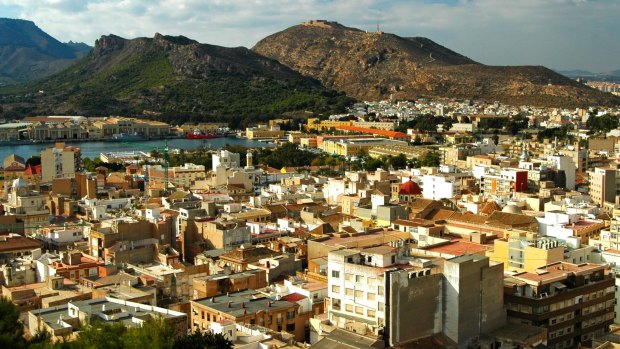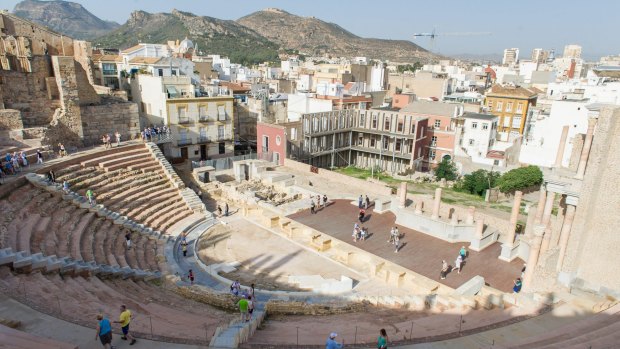This was published 6 years ago
Cartagena, Spain: The astonishing Roman ruin that keeps disappearing

Cartagena has been an important naval base since the 16th century.Credit: Alamy
Cartagena, tucked into a well-defended fold of coastline between Malaga and Valencia, has been a deep-water port since Carthaginian times, and an important naval base since the 16th century.
My APT cruise ship Hebridean Sky creeps into its bay past bare brown hills topped by crumbling forts and quivering antennae. I can smell an oil refinery and hot sun on warehouses. Cranes swivel like giant claws above naval vessels sleek as porpoises.
No surprise that such a strategic location was noticed by the avaricious Romans. They came, they saw and, in the 1st century BC, they carved out half a hill and built a 6000-seat theatre bigger than Ben Hur, plonk in the middle of their thriving outpost. There it sat for more than a millennium, back to the harbour, view over the stage to Murcia's purple hills, and easily the biggest man-made structure anyone had ever clapped eyes on.

The Roman Theatre is an astonishing place in an astonishing setting.Credit: Alamy
And then it was lost. First, as early as the 3rd century, came a market. Then medieval townspeople thought one corner quite the place for a cathedral – after all, the foundations were sound and ready stone blocks lay in convenient tiers. In the 16th century, Cartagena boomed and the theatre's stage provided open space for house building. Then a downturn came and fishermen moved in. The buildings became tenements and the theatre was swallowed under superimposed layers.
In the early 20th century, mining brought wealth and Art Nouveau redevelopment, yet still the Roman theatre went unnoticed. Only in 1987 did some bright renovation rescuer notice that his basement was sitting plumb atop a fabulous find: not just a theatre the size of a shopping mall, but Apollo statues, nymph-decorated urns, Byzantine glassware, plumbing, water tanks and all. It took two decades to complete the excavations.
It's a short walk from Cartagena's modest cruise terminal and yacht harbour, across a promenade and garden, into this lively town of recovered treasures. Its modern architecture is more immediately apparent. Our shore excursion group stops at the town hall, a Belle Époque wonder of white marble and zinc domes, peppered with bullet holes from the Spanish Civil War. From here Calle Mayor, paved in blue marble, runs in a canyon of Modernist buildings through the town centre; a favourite route for the paseo, Spain's sociable afternoon strolling.
A modest door marks the entrance to the Roman Theatre, as if echoing its overlooked centuries. At first, we enter a museum building designed by a leading Spanish architect in a clever arrangement of ascending escalators and light-flooded, minimalist spaces that display the amphorae, glassware and statues unearthed during excavations. By the time we pop out at the top of the building, we've ascended through two millennia of layers to step out into the theatre's lower level. It rises in terraced seats to the thorny crown of the cathedral, ruined by Civil-War shelling. The theatre is surrounded by apartment blocks where washing flaps and potted plants wilt: an astonishing place in an astonishing setting.
This isn't Cartagena's only Roman marvel. Our local APT guide Pedro leads us onwards, past tapas bars and shops, to the ruins of the Roman forum and surrounding structures: thermal baths, a mosaic-floored banqueting hall, the worn-smooth flagstones of a well-engineered Roman road that runs beneath the walls of a pizza restaurant. Follow it a few blocks east, and the 1st-century Casa de la Fortuna villa is a glimpse into well-heeled Roman living, in which patches of mosaic and frescoes gleam.
You'll have a dilemma when your tour group insights are completed and free time propels you around the compact town centre. You could walk up to Plaza San Sebastían, where the Modernist Gran Hotel vies with the 1739 naval headquarters for opulence. You could head to the National Museum of Underwater Archaeology, which takes a panoramic view of Mediterranean maritime history. It has a replica Phoenician ship and Roman galley, and recovered trade artefacts including ivory tusks, Islamic dishes and gold coins.
On the other hand, you could just join the locals in one of Cartagena's many tapas bars, and enjoy a taste of Roman life yourself. After all, the Romans were the original indulgent eaters, with a taste for shrimps, sea urchins and milk-fattened snails. They introduced olive trees to Spain and conducted a lively trade in Spanish wines, a glass or two of which will propel you back to your ship feeling rather pleased at having uncovered Cartagena's pleasures.
See also: The tropical paradise that's a well-guarded secret
See also: 20 things that will surprise first-time visitors to Italy
TRIP NOTES
MORE
CRUISE
APT's 15-day "Southern European Sojourn" between London and Barcelona is priced from $15,995pp including shore excursions, gratuities and beverages. It next departs on May 15, 2018. Phone 1300 196 420. See aptouring.com.au
Brian Johnston travelled as a guest of APT.
Sign up for the Traveller Deals newsletter
Get exclusive travel deals delivered straight to your inbox. Sign up now.